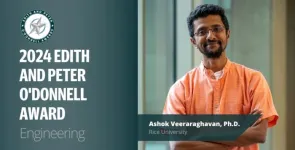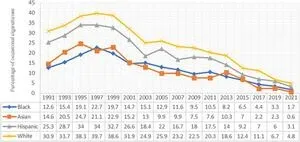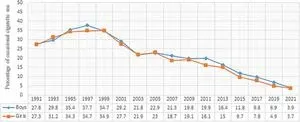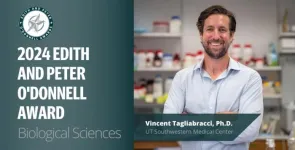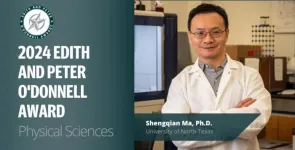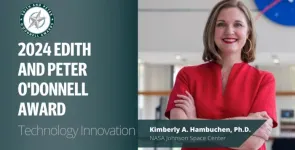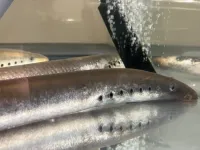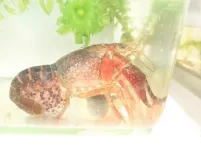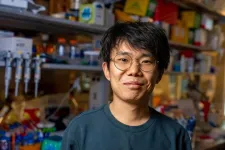(Press-News.org) Trailblazing engineer Ashok Veeraraghavan, Ph.D., Professor of Electrical and Computer Engineering and Computer Science, George R. Brown School of Engineering at Rice University, is the recipient of the 2024 Edith and Peter O’Donnell Award in Engineering from TAMEST (Texas Academy of Medicine, Engineering, Science and Technology). He was chosen for his revolutionary imaging technology that seeks to make the invisible visible. View a video on Dr. Veeraraghavan's groundbreaking research here.
Imagine taking a pristine picture through fog, smoke and rain. Imagine taking interior images of the human body through skin, bone and other tissue that scatter light and limit human vision. Dr. Veeraraghavan and his team at Rice work on creating imaging systems that use novel multi-dimensional image sensors along with machine learning algorithms to undo the effects of light-scattering and see-through scattering media such as fog, smoke, rain and human tissue.
Recently, with support from researchers at the University of Maryland, his team has developed a new technology dubbed NeuWS, an acronym for “neural wavefront shaping.” At its core, NeuWS is about undoing the effects of light scattering by using wavefront shaping and a novel machine-learning algorithm. Scattering is what makes light, which has a lower wavelength unusable in many scenarios. If you can undo the effects of scattering, imaging can go much further.
Capturing images through rain and fog is certainly interesting, but this technology could have lifesaving applications. Through NeuWS-like technologies, there could be a time in the future where a firefighter entering into a room filled with smoke could be equipped with goggles that allow them to have clear visibility. Automakers could be able to install car headlights that can see through a host of dangerous weather conditions. Surgeons could be able to see blood vessels through the skin tissue without making a single cut. While several further advances are needed to make any of these scenarios possible, their work has made significant progress and make all of this potentially feasible.
“Dr. Veeraraghavan is tackling one of the hardest problems in imaging, what many consider to be a ‘holy grail problem’ of optical engineering,” said nominator Alan Bovik, Ph.D. (NAE), Professor, Cockrell Family Regents Endowed Chair in Engineering at The University of Texas at Austin. “Every time we improve our ability to see what is unseen, the number of things we can do increases. The NeuWS technology is going to allow us to see things we cannot even imagine today.”
Dr. Veeraraghavan is one of five Texas-based researchers receiving the TAMEST 2024 Edith and Peter O’Donnell Awards. Each are chosen for their individual contributions addressing the essential role that science and technology play in society, and whose work meets the highest standards of exemplary professional performance, creativity and resourcefulness.
“The Edith and Peter O’Donnell Awards bring together a broad group of disciplines and expertise and creates the space to talk about cross-disciplinary approaches to future solutions – and we couldn’t be prouder of this year’s group of innovative recipients,” said Edith and Peter O’Donnell Awards Committee Chair Oliver Mullins, Ph.D. (NAE), SLB Fellow, SLB. “These researchers are transforming the future of science and innovation in our state, and these awards are an important mechanism for maintaining a link between academia and industry and moving the research needle forward for our society.”
Over $1.5 million has been awarded to more than 75 recipients in the categories of Medicine, Engineering, Biological Sciences, Physical Sciences and Technology Innovation since the inception of the O'Donnell Awards in 2006. Sixteen O’Donnell Awards Recipients have gone on to be elected to the National Academies, including four who hold dual academy elections.
Dr. Veeraraghavan will be recognized at the 2024 Edith and Peter O’Donnell Awards Ceremony on Tuesday, February 6, 2024, and will give a presentation on his research preceding the award ceremony at the TAMEST 2024 Annual Conference: Artificial Intelligence and Machine Learning in Austin, Texas, at the AT&T Hotel and Conference Center.
All are encouraged to attend the ceremony and the TAMEST Conference.
Full list of 2024 Edith and Peter O'Donnell Award Recipients:
• Medicine: Benjamin Deneen, Ph.D., Baylor College of Medicine
• Engineering: Ashok Veeraraghavan, Ph.D., Rice University
• Biological Sciences: Vincent Tagliabracci, Ph.D., UT Southwestern Medical Center
• Physical Sciences: Shengqian Ma, Ph.D., University of North Texas
• Technology Innovation: Kimberly A. Hambuchen, Ph.D., NASA Johnson Space Center
About the O’Donnell Awards:
The Edith and Peter O’Donnell Awards annually recognize rising star Texas researchers who are addressing the essential role that science and technology play in society, and whose work meets the highest standards of exemplary professional performance, creativity and resourcefulness.
Thanks to a $1.15 million gift from the O’Donnell Foundation in 2022, the O’Donnell Awards have expanded to include an additional science award. The awards now recognize recipients in the categories of Medicine, Engineering, Biological Sciences, Physical Sciences and Technology Innovation. (Previously, the TAMEST O’Donnell Awards rotated its science award between physical and biological sciences every year.)
The Edith and Peter O’Donnell Awards are made possible by the O’Donnell Awards Endowment Fund, established in 2005 through the generous support of several individuals and organizations. View a full list of supporters here.
About TAMEST:
TAMEST was co-founded in 2004 by the Honorable Kay Bailey Hutchison and Nobel Laureates Michael S. Brown, M.D., and Richard E. Smalley, Ph.D. With more than 335 members and 22 member institutions, TAMEST is composed of the Texas-based members of the three National Academies (National Academy of Medicine, National Academy of Engineering and National Academy of Sciences), the Royal Society and the state’s eight Nobel Laureates. We bring together the state’s brightest minds in medicine, engineering, science and technology to foster collaboration, and to advance research, innovation and business in Texas.
TAMEST’s unique interdisciplinary model has become an effective recruitment tool for top research and development centers across Texas. Since our founding, more than 275 TAMEST members have been inducted into the National Academies or relocated to Texas.
###
END
Forward-thinking biochemist Vincent Tagliabracci, Ph.D., Associate Professor at UT Southwestern Medical Center, is the recipient of the 2024 Edith and Peter O’Donnell Award in Biological Sciences from TAMEST (Texas Academy of Medicine, Engineering, Science and Technology). He was chosen for his potentially life-saving research in understanding how enzymes work. View a video on Dr. Tagliabracci's groundbreaking research here.
Dr. Tagliabracci and his team at UT Southwestern Medical Center have shined a new light on an array of physiological processes that rely on enzymes called protein kinases (PKs) and their biological cousins called ...
A worldwide leader in nanoporous materials research, Shengqian Ma, Ph.D., Professor and Welch Chair in Chemistry, the University of North Texas, is the recipient of the 2024 Edith and Peter O’Donnell Award in Physical Sciences from TAMEST (Texas Academy of Medicine, Engineering, Science and Technology). He was chosen for his innovative work in the field of decontamination. View a video on Dr. Ma's groundbreaking research here.
In a time of growing concern for the Earth and humanity’s ecosystem, Dr. Ma’s work could have an incredibly important impact on environmental and energy sustainability. His research was primarily ...
A true pioneer in space, robotics engineer Kimberly A. Hambuchen, Ph.D., Deputy Chief, Software, Robotics and Simulation Division at NASA Johnson Space Center, is the recipient of the 2024 Edith and Peter O’Donnell Award in Technology Innovation from TAMEST (Texas Academy of Medicine, Engineering, Science and Technology). She was chosen for her seminal research in developing new methods for making robots more autonomous and usable by humans across a time delay. View a video on Dr. Hambuchen's groundbreaking research here.
Dr. Hambuchen’s research focuses on human-robot ...
COLUMBUS, Ohio – Teens from larger families have poorer mental health than those with fewer siblings, according to a large analysis of children in the United States and China.
The details of the pattern vary depending on factors such as the spacing of sibling ages and the age of the siblings.
But the fact that the overall pattern was found in both countries is striking, said Doug Downey, lead author of the study and professor of sociology at The Ohio State University.
“Our results couldn’t have been easily predicted before we did the study,” Downey said.
“Other studies have shown that having more siblings ...
The origin of the vertebrate skull is a topic of much debate among evolutionary biologists. Some believe that the vertebrate head has developed as a result of modification of the segmental elements of the trunk, such as the vertebrae and somites. On the other hand, others believe that the vertebrate head has evolved as a new, unsegment body part, unrelated to other widely observed embryonic segments somites. Interestingly, previous studies on embryos have revealed the presence of some vestiges of somites ...
Procambarus clarkii is a crustacean species native to American freshwater bodies. Brought to Japan in the 1920s as a feed for frogs, this crustacean has slowly taken over the Japanese freshwaters by predation and propagation. In fact, in 2023, the red-swamp crayfish was designated as an invasive alien species by the Japanese Ministry of the Environment and of the Agriculture, Forestry and Fisheries.
One way to control the growth in population of red-swamp crayfish and the accompanying crisis is to capture the red-swamp crayfish in their reproductive ...
Research Highlights:
Despite drops in overall cardiovascular disease deaths from 1999-2019, cardiovascular disease deaths in which substance use was cited as a contributing factor increased an average of 4% per year, with the death rate accelerating to 6.2% from 2012-2019.
Prominent increases in cardiovascular deaths associated with substance use were most notable among women, American Indian or Alaskan individuals, younger individuals, rural area residents and users of cannabis and psychostimulants.
Identifying high-risk groups is crucial for prioritizing preventive measures to reduce substance use linked with cardiovascular disease deaths, particularly ...
CAMBRIDGE, MA -- Sequencing all of the RNA in a cell can reveal a great deal of information about that cell’s function and what it is doing at a given point in time. However, the sequencing process destroys the cell, making it difficult to study ongoing changes in gene expression.
An alternative approach developed at MIT could enable researchers to track such changes over extended periods of time. The new method, which is based on a noninvasive imaging technique known as Raman spectroscopy, doesn’t harm cells and can be performed repeatedly.
Using ...
HOUSTON – (Jan. 10, 2023) – The brain is the most protected organ in the body, sheathed in a complex and nearly impenetrable barrier of specialized blood vessels. While this particular anatomical setup protects it from outside invaders, it also makes it difficult for researchers to study how specific genes are expressed ⎯ and how such changes in gene expression may lead to disease.
Now Rice University scientists have developed a noninvasive way to monitor gene expression dynamics in the brain, making it easier to investigate brain ...
Barcelona, 10 January 2024 – Mutations, which occur continuously in every cell of our bodies, are a key contributor to cancer, ageing, and neurodegeneration. While exposure to mutagenic chemicals, or mistakes in cellular processes during DNA replication contribute to these mutations, the exact distribution and patterns of these changes across human chromosomes have remained a mystery until now.
Dr. Fran Supek, ICREA researcher and head of the Genome Data Science lab at IRB Barcelona, and Marina Salvadores, PhD student ...
